Analyzing Community and Public Health Nutrition: Obesity & Australia
VerifiedAdded on 2023/06/11
|17
|4193
|279
Report
AI Summary
This report examines community and public health nutrition, addressing the critical issue of obesity and sedentary lifestyles among youth in China and malnutrition in Australia. It highlights the prevalence of obesity, its impact on physical and mental health, and the influence of factors like physical inactivity and western-style nutrition. The report proposes using educational sessions to motivate young adults to adopt more active lifestyles, with quantitative data collection to measure changes in motivation. Furthermore, the report addresses malnutrition in Australia, emphasizing its under-recognized status and significant impact on healthcare costs and patient well-being. It identifies vulnerable populations and calls for integrated, evidence-based strategies to improve nutritional outcomes, highlighting the importance of government support and innovative interventions. Desklib offers this report as a valuable resource, providing students with access to past papers and solved assignments.
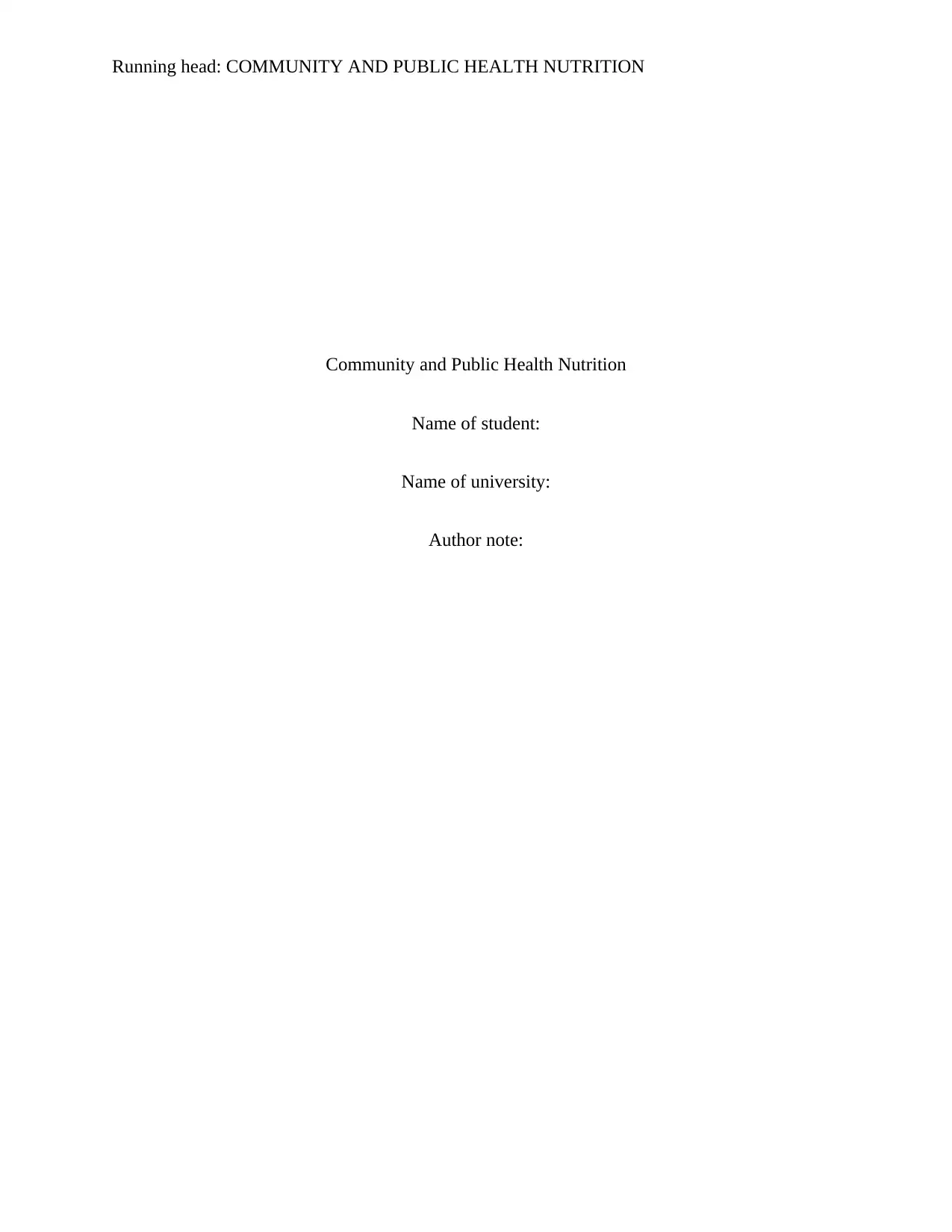
Running head: COMMUNITY AND PUBLIC HEALTH NUTRITION
Community and Public Health Nutrition
Name of student:
Name of university:
Author note:
Community and Public Health Nutrition
Name of student:
Name of university:
Author note:
Paraphrase This Document
Need a fresh take? Get an instant paraphrase of this document with our AI Paraphraser
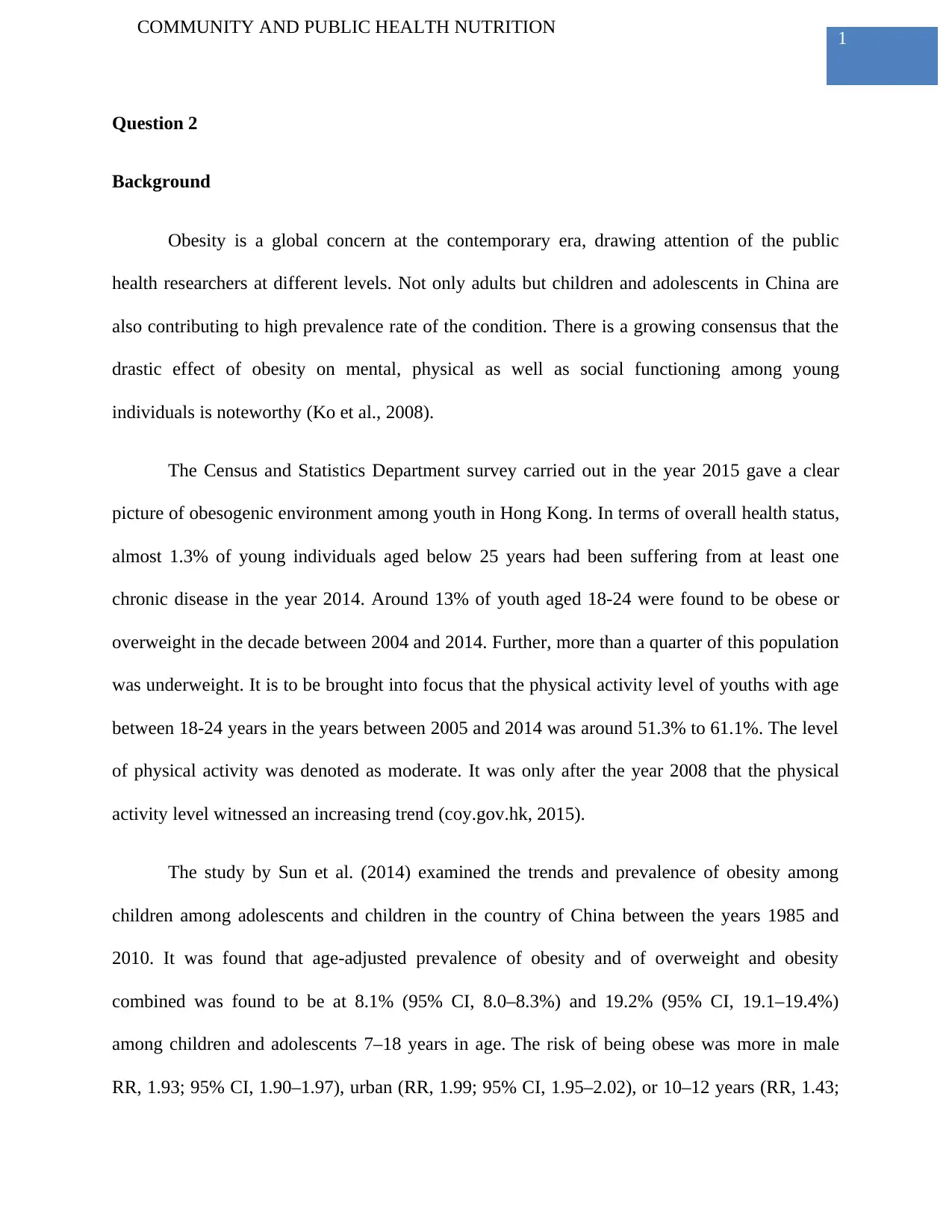
1
COMMUNITY AND PUBLIC HEALTH NUTRITION
Question 2
Background
Obesity is a global concern at the contemporary era, drawing attention of the public
health researchers at different levels. Not only adults but children and adolescents in China are
also contributing to high prevalence rate of the condition. There is a growing consensus that the
drastic effect of obesity on mental, physical as well as social functioning among young
individuals is noteworthy (Ko et al., 2008).
The Census and Statistics Department survey carried out in the year 2015 gave a clear
picture of obesogenic environment among youth in Hong Kong. In terms of overall health status,
almost 1.3% of young individuals aged below 25 years had been suffering from at least one
chronic disease in the year 2014. Around 13% of youth aged 18-24 were found to be obese or
overweight in the decade between 2004 and 2014. Further, more than a quarter of this population
was underweight. It is to be brought into focus that the physical activity level of youths with age
between 18-24 years in the years between 2005 and 2014 was around 51.3% to 61.1%. The level
of physical activity was denoted as moderate. It was only after the year 2008 that the physical
activity level witnessed an increasing trend (coy.gov.hk, 2015).
The study by Sun et al. (2014) examined the trends and prevalence of obesity among
children among adolescents and children in the country of China between the years 1985 and
2010. It was found that age-adjusted prevalence of obesity and of overweight and obesity
combined was found to be at 8.1% (95% CI, 8.0–8.3%) and 19.2% (95% CI, 19.1–19.4%)
among children and adolescents 7–18 years in age. The risk of being obese was more in male
RR, 1.93; 95% CI, 1.90–1.97), urban (RR, 1.99; 95% CI, 1.95–2.02), or 10–12 years (RR, 1.43;
COMMUNITY AND PUBLIC HEALTH NUTRITION
Question 2
Background
Obesity is a global concern at the contemporary era, drawing attention of the public
health researchers at different levels. Not only adults but children and adolescents in China are
also contributing to high prevalence rate of the condition. There is a growing consensus that the
drastic effect of obesity on mental, physical as well as social functioning among young
individuals is noteworthy (Ko et al., 2008).
The Census and Statistics Department survey carried out in the year 2015 gave a clear
picture of obesogenic environment among youth in Hong Kong. In terms of overall health status,
almost 1.3% of young individuals aged below 25 years had been suffering from at least one
chronic disease in the year 2014. Around 13% of youth aged 18-24 were found to be obese or
overweight in the decade between 2004 and 2014. Further, more than a quarter of this population
was underweight. It is to be brought into focus that the physical activity level of youths with age
between 18-24 years in the years between 2005 and 2014 was around 51.3% to 61.1%. The level
of physical activity was denoted as moderate. It was only after the year 2008 that the physical
activity level witnessed an increasing trend (coy.gov.hk, 2015).
The study by Sun et al. (2014) examined the trends and prevalence of obesity among
children among adolescents and children in the country of China between the years 1985 and
2010. It was found that age-adjusted prevalence of obesity and of overweight and obesity
combined was found to be at 8.1% (95% CI, 8.0–8.3%) and 19.2% (95% CI, 19.1–19.4%)
among children and adolescents 7–18 years in age. The risk of being obese was more in male
RR, 1.93; 95% CI, 1.90–1.97), urban (RR, 1.99; 95% CI, 1.95–2.02), or 10–12 years (RR, 1.43;
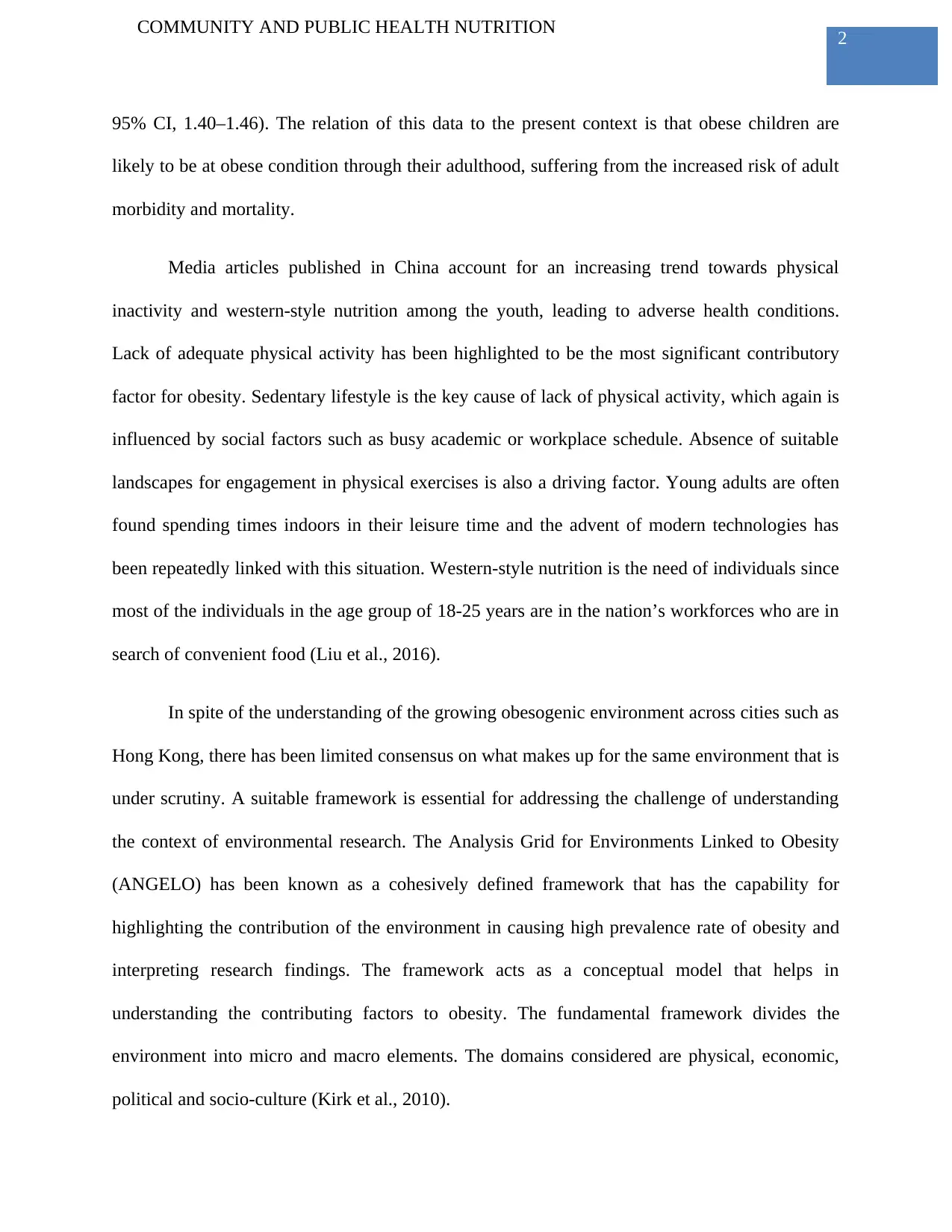
2
COMMUNITY AND PUBLIC HEALTH NUTRITION
95% CI, 1.40–1.46). The relation of this data to the present context is that obese children are
likely to be at obese condition through their adulthood, suffering from the increased risk of adult
morbidity and mortality.
Media articles published in China account for an increasing trend towards physical
inactivity and western-style nutrition among the youth, leading to adverse health conditions.
Lack of adequate physical activity has been highlighted to be the most significant contributory
factor for obesity. Sedentary lifestyle is the key cause of lack of physical activity, which again is
influenced by social factors such as busy academic or workplace schedule. Absence of suitable
landscapes for engagement in physical exercises is also a driving factor. Young adults are often
found spending times indoors in their leisure time and the advent of modern technologies has
been repeatedly linked with this situation. Western-style nutrition is the need of individuals since
most of the individuals in the age group of 18-25 years are in the nation’s workforces who are in
search of convenient food (Liu et al., 2016).
In spite of the understanding of the growing obesogenic environment across cities such as
Hong Kong, there has been limited consensus on what makes up for the same environment that is
under scrutiny. A suitable framework is essential for addressing the challenge of understanding
the context of environmental research. The Analysis Grid for Environments Linked to Obesity
(ANGELO) has been known as a cohesively defined framework that has the capability for
highlighting the contribution of the environment in causing high prevalence rate of obesity and
interpreting research findings. The framework acts as a conceptual model that helps in
understanding the contributing factors to obesity. The fundamental framework divides the
environment into micro and macro elements. The domains considered are physical, economic,
political and socio-culture (Kirk et al., 2010).
COMMUNITY AND PUBLIC HEALTH NUTRITION
95% CI, 1.40–1.46). The relation of this data to the present context is that obese children are
likely to be at obese condition through their adulthood, suffering from the increased risk of adult
morbidity and mortality.
Media articles published in China account for an increasing trend towards physical
inactivity and western-style nutrition among the youth, leading to adverse health conditions.
Lack of adequate physical activity has been highlighted to be the most significant contributory
factor for obesity. Sedentary lifestyle is the key cause of lack of physical activity, which again is
influenced by social factors such as busy academic or workplace schedule. Absence of suitable
landscapes for engagement in physical exercises is also a driving factor. Young adults are often
found spending times indoors in their leisure time and the advent of modern technologies has
been repeatedly linked with this situation. Western-style nutrition is the need of individuals since
most of the individuals in the age group of 18-25 years are in the nation’s workforces who are in
search of convenient food (Liu et al., 2016).
In spite of the understanding of the growing obesogenic environment across cities such as
Hong Kong, there has been limited consensus on what makes up for the same environment that is
under scrutiny. A suitable framework is essential for addressing the challenge of understanding
the context of environmental research. The Analysis Grid for Environments Linked to Obesity
(ANGELO) has been known as a cohesively defined framework that has the capability for
highlighting the contribution of the environment in causing high prevalence rate of obesity and
interpreting research findings. The framework acts as a conceptual model that helps in
understanding the contributing factors to obesity. The fundamental framework divides the
environment into micro and macro elements. The domains considered are physical, economic,
political and socio-culture (Kirk et al., 2010).
⊘ This is a preview!⊘
Do you want full access?
Subscribe today to unlock all pages.

Trusted by 1+ million students worldwide
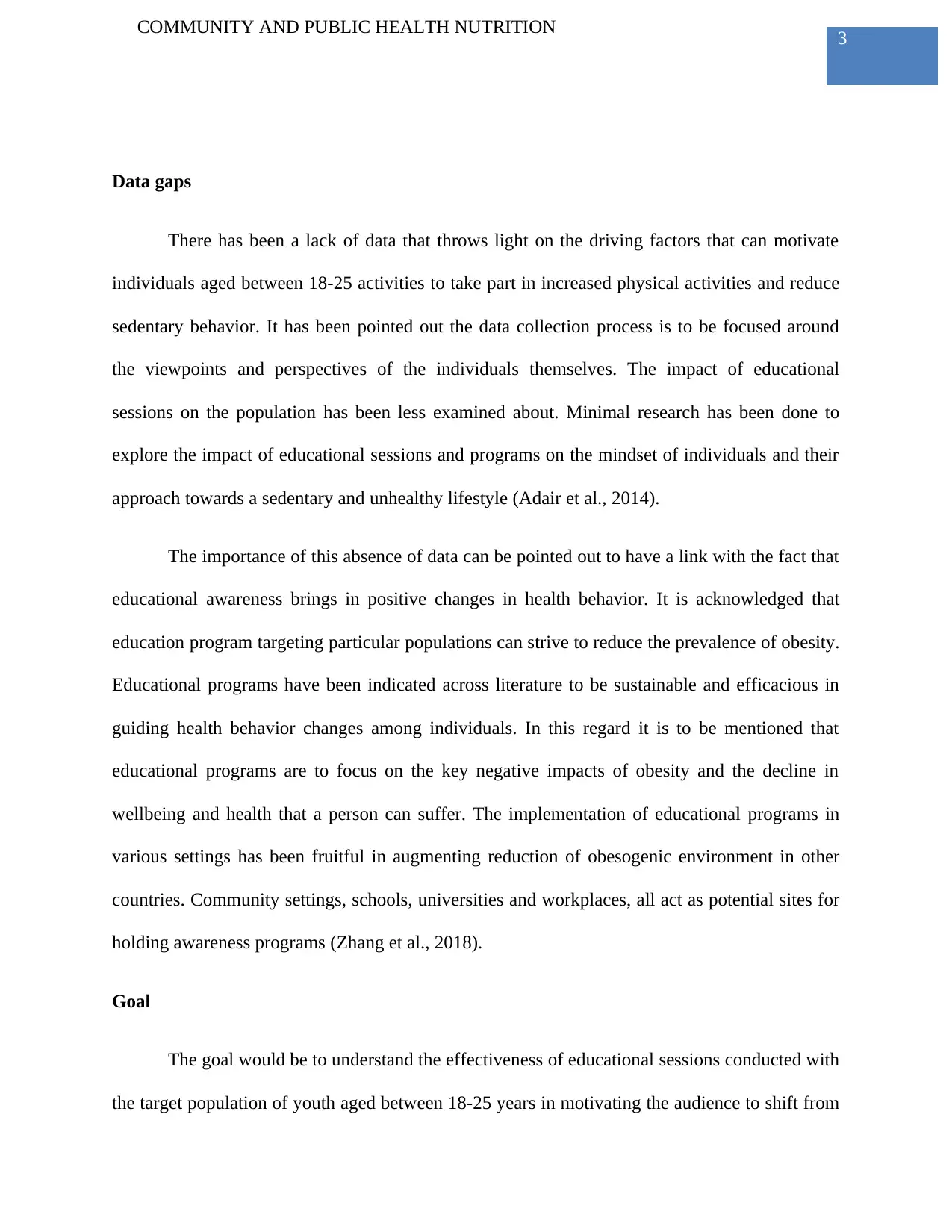
3
COMMUNITY AND PUBLIC HEALTH NUTRITION
Data gaps
There has been a lack of data that throws light on the driving factors that can motivate
individuals aged between 18-25 activities to take part in increased physical activities and reduce
sedentary behavior. It has been pointed out the data collection process is to be focused around
the viewpoints and perspectives of the individuals themselves. The impact of educational
sessions on the population has been less examined about. Minimal research has been done to
explore the impact of educational sessions and programs on the mindset of individuals and their
approach towards a sedentary and unhealthy lifestyle (Adair et al., 2014).
The importance of this absence of data can be pointed out to have a link with the fact that
educational awareness brings in positive changes in health behavior. It is acknowledged that
education program targeting particular populations can strive to reduce the prevalence of obesity.
Educational programs have been indicated across literature to be sustainable and efficacious in
guiding health behavior changes among individuals. In this regard it is to be mentioned that
educational programs are to focus on the key negative impacts of obesity and the decline in
wellbeing and health that a person can suffer. The implementation of educational programs in
various settings has been fruitful in augmenting reduction of obesogenic environment in other
countries. Community settings, schools, universities and workplaces, all act as potential sites for
holding awareness programs (Zhang et al., 2018).
Goal
The goal would be to understand the effectiveness of educational sessions conducted with
the target population of youth aged between 18-25 years in motivating the audience to shift from
COMMUNITY AND PUBLIC HEALTH NUTRITION
Data gaps
There has been a lack of data that throws light on the driving factors that can motivate
individuals aged between 18-25 activities to take part in increased physical activities and reduce
sedentary behavior. It has been pointed out the data collection process is to be focused around
the viewpoints and perspectives of the individuals themselves. The impact of educational
sessions on the population has been less examined about. Minimal research has been done to
explore the impact of educational sessions and programs on the mindset of individuals and their
approach towards a sedentary and unhealthy lifestyle (Adair et al., 2014).
The importance of this absence of data can be pointed out to have a link with the fact that
educational awareness brings in positive changes in health behavior. It is acknowledged that
education program targeting particular populations can strive to reduce the prevalence of obesity.
Educational programs have been indicated across literature to be sustainable and efficacious in
guiding health behavior changes among individuals. In this regard it is to be mentioned that
educational programs are to focus on the key negative impacts of obesity and the decline in
wellbeing and health that a person can suffer. The implementation of educational programs in
various settings has been fruitful in augmenting reduction of obesogenic environment in other
countries. Community settings, schools, universities and workplaces, all act as potential sites for
holding awareness programs (Zhang et al., 2018).
Goal
The goal would be to understand the effectiveness of educational sessions conducted with
the target population of youth aged between 18-25 years in motivating the audience to shift from
Paraphrase This Document
Need a fresh take? Get an instant paraphrase of this document with our AI Paraphraser
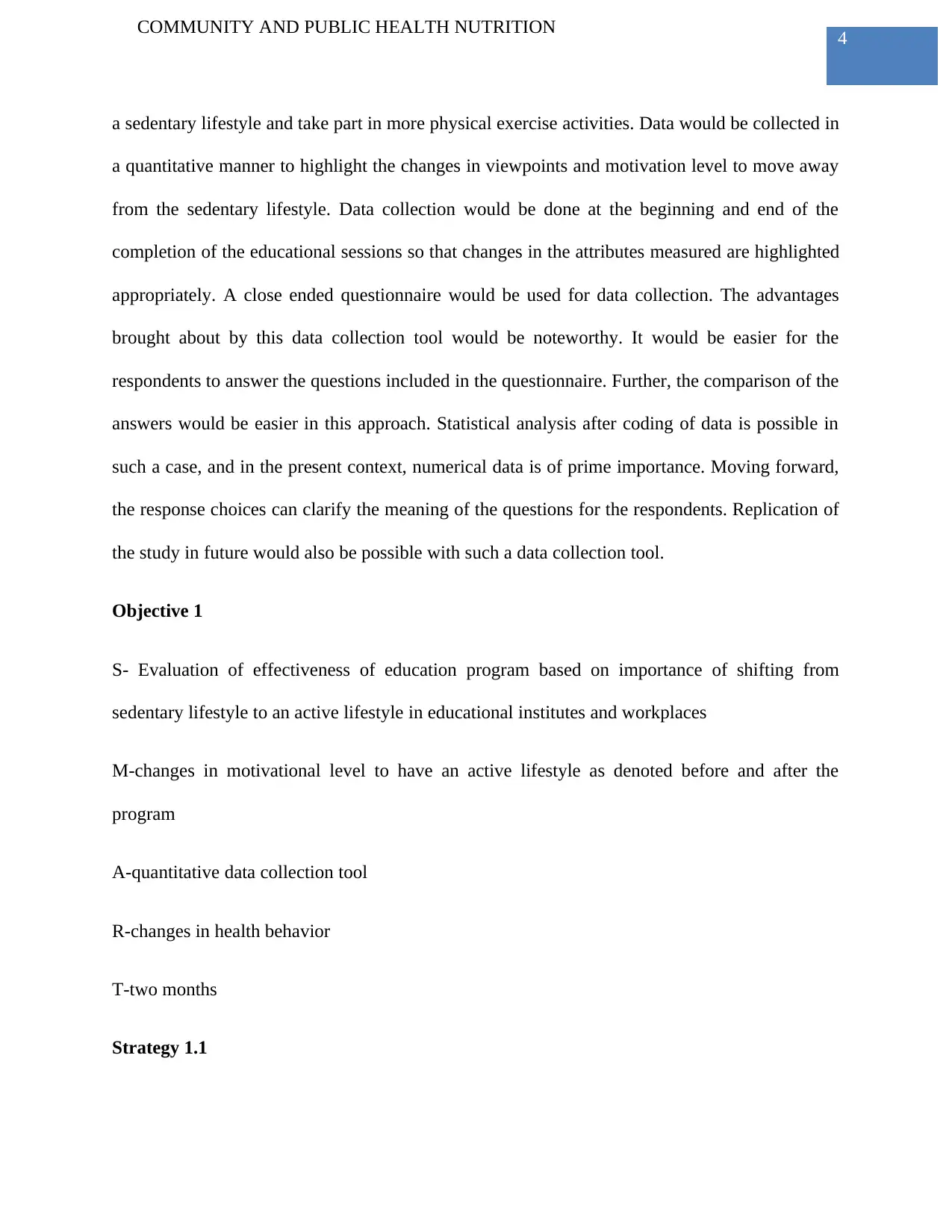
4
COMMUNITY AND PUBLIC HEALTH NUTRITION
a sedentary lifestyle and take part in more physical exercise activities. Data would be collected in
a quantitative manner to highlight the changes in viewpoints and motivation level to move away
from the sedentary lifestyle. Data collection would be done at the beginning and end of the
completion of the educational sessions so that changes in the attributes measured are highlighted
appropriately. A close ended questionnaire would be used for data collection. The advantages
brought about by this data collection tool would be noteworthy. It would be easier for the
respondents to answer the questions included in the questionnaire. Further, the comparison of the
answers would be easier in this approach. Statistical analysis after coding of data is possible in
such a case, and in the present context, numerical data is of prime importance. Moving forward,
the response choices can clarify the meaning of the questions for the respondents. Replication of
the study in future would also be possible with such a data collection tool.
Objective 1
S- Evaluation of effectiveness of education program based on importance of shifting from
sedentary lifestyle to an active lifestyle in educational institutes and workplaces
M-changes in motivational level to have an active lifestyle as denoted before and after the
program
A-quantitative data collection tool
R-changes in health behavior
T-two months
Strategy 1.1
COMMUNITY AND PUBLIC HEALTH NUTRITION
a sedentary lifestyle and take part in more physical exercise activities. Data would be collected in
a quantitative manner to highlight the changes in viewpoints and motivation level to move away
from the sedentary lifestyle. Data collection would be done at the beginning and end of the
completion of the educational sessions so that changes in the attributes measured are highlighted
appropriately. A close ended questionnaire would be used for data collection. The advantages
brought about by this data collection tool would be noteworthy. It would be easier for the
respondents to answer the questions included in the questionnaire. Further, the comparison of the
answers would be easier in this approach. Statistical analysis after coding of data is possible in
such a case, and in the present context, numerical data is of prime importance. Moving forward,
the response choices can clarify the meaning of the questions for the respondents. Replication of
the study in future would also be possible with such a data collection tool.
Objective 1
S- Evaluation of effectiveness of education program based on importance of shifting from
sedentary lifestyle to an active lifestyle in educational institutes and workplaces
M-changes in motivational level to have an active lifestyle as denoted before and after the
program
A-quantitative data collection tool
R-changes in health behavior
T-two months
Strategy 1.1
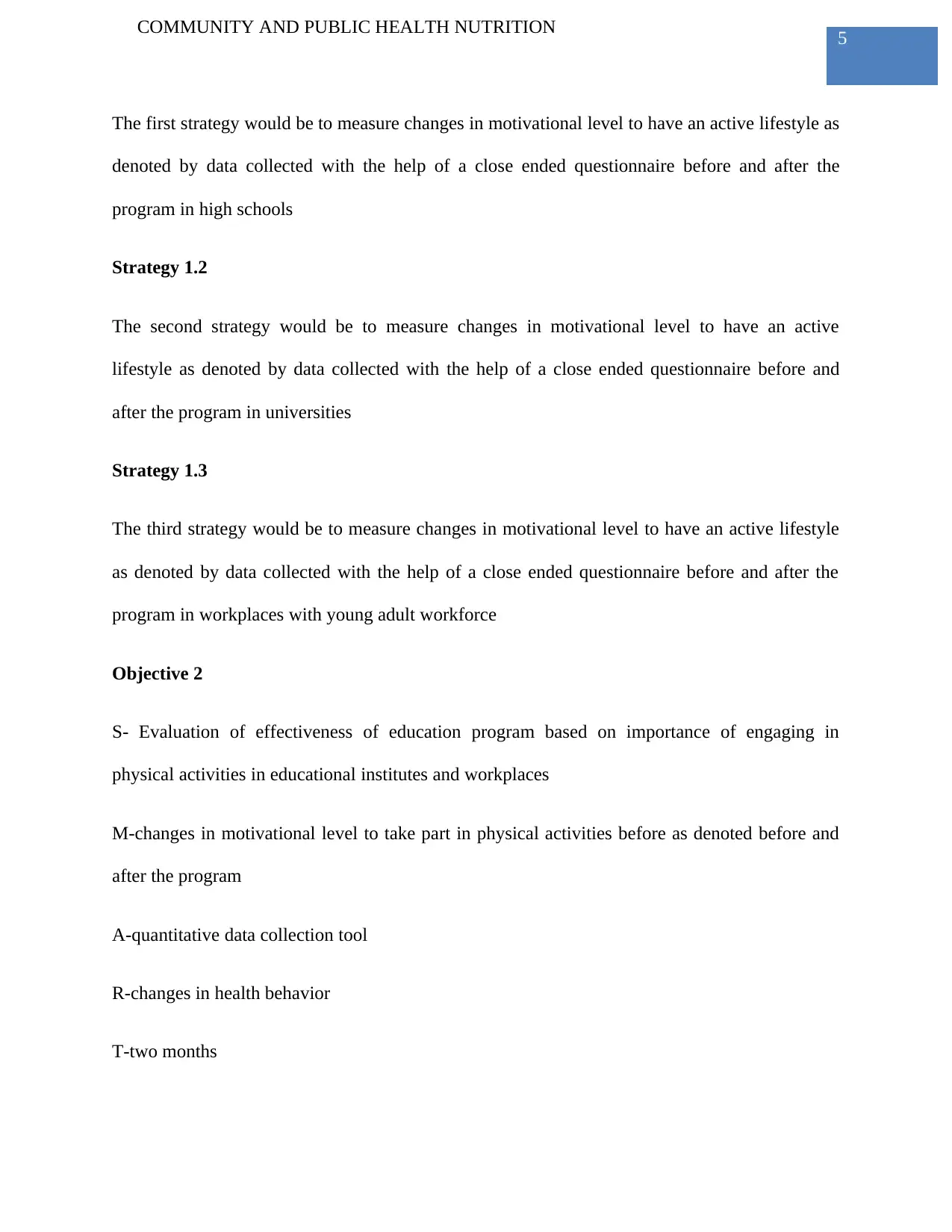
5
COMMUNITY AND PUBLIC HEALTH NUTRITION
The first strategy would be to measure changes in motivational level to have an active lifestyle as
denoted by data collected with the help of a close ended questionnaire before and after the
program in high schools
Strategy 1.2
The second strategy would be to measure changes in motivational level to have an active
lifestyle as denoted by data collected with the help of a close ended questionnaire before and
after the program in universities
Strategy 1.3
The third strategy would be to measure changes in motivational level to have an active lifestyle
as denoted by data collected with the help of a close ended questionnaire before and after the
program in workplaces with young adult workforce
Objective 2
S- Evaluation of effectiveness of education program based on importance of engaging in
physical activities in educational institutes and workplaces
M-changes in motivational level to take part in physical activities before as denoted before and
after the program
A-quantitative data collection tool
R-changes in health behavior
T-two months
COMMUNITY AND PUBLIC HEALTH NUTRITION
The first strategy would be to measure changes in motivational level to have an active lifestyle as
denoted by data collected with the help of a close ended questionnaire before and after the
program in high schools
Strategy 1.2
The second strategy would be to measure changes in motivational level to have an active
lifestyle as denoted by data collected with the help of a close ended questionnaire before and
after the program in universities
Strategy 1.3
The third strategy would be to measure changes in motivational level to have an active lifestyle
as denoted by data collected with the help of a close ended questionnaire before and after the
program in workplaces with young adult workforce
Objective 2
S- Evaluation of effectiveness of education program based on importance of engaging in
physical activities in educational institutes and workplaces
M-changes in motivational level to take part in physical activities before as denoted before and
after the program
A-quantitative data collection tool
R-changes in health behavior
T-two months
⊘ This is a preview!⊘
Do you want full access?
Subscribe today to unlock all pages.

Trusted by 1+ million students worldwide
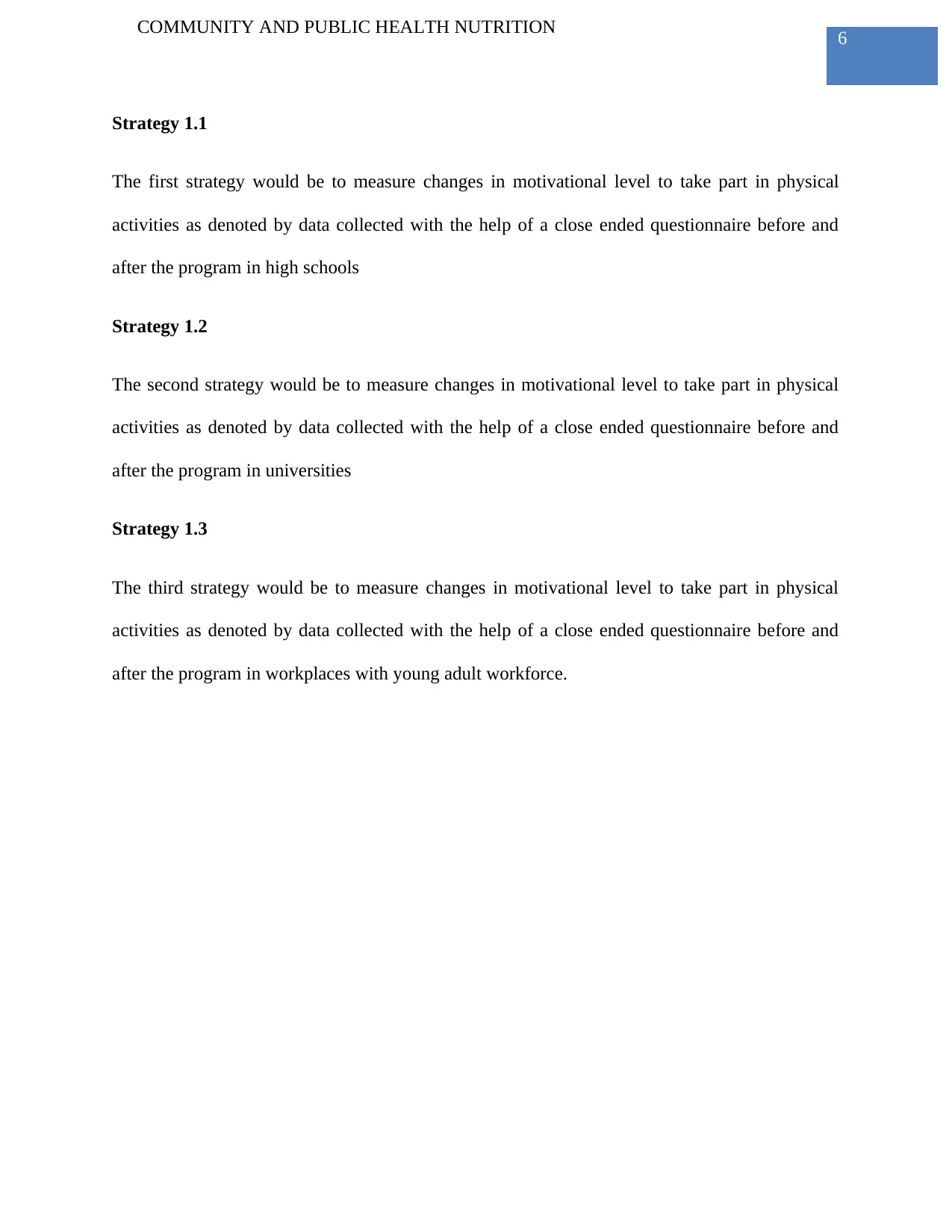
6
COMMUNITY AND PUBLIC HEALTH NUTRITION
Strategy 1.1
The first strategy would be to measure changes in motivational level to take part in physical
activities as denoted by data collected with the help of a close ended questionnaire before and
after the program in high schools
Strategy 1.2
The second strategy would be to measure changes in motivational level to take part in physical
activities as denoted by data collected with the help of a close ended questionnaire before and
after the program in universities
Strategy 1.3
The third strategy would be to measure changes in motivational level to take part in physical
activities as denoted by data collected with the help of a close ended questionnaire before and
after the program in workplaces with young adult workforce.
COMMUNITY AND PUBLIC HEALTH NUTRITION
Strategy 1.1
The first strategy would be to measure changes in motivational level to take part in physical
activities as denoted by data collected with the help of a close ended questionnaire before and
after the program in high schools
Strategy 1.2
The second strategy would be to measure changes in motivational level to take part in physical
activities as denoted by data collected with the help of a close ended questionnaire before and
after the program in universities
Strategy 1.3
The third strategy would be to measure changes in motivational level to take part in physical
activities as denoted by data collected with the help of a close ended questionnaire before and
after the program in workplaces with young adult workforce.
Paraphrase This Document
Need a fresh take? Get an instant paraphrase of this document with our AI Paraphraser
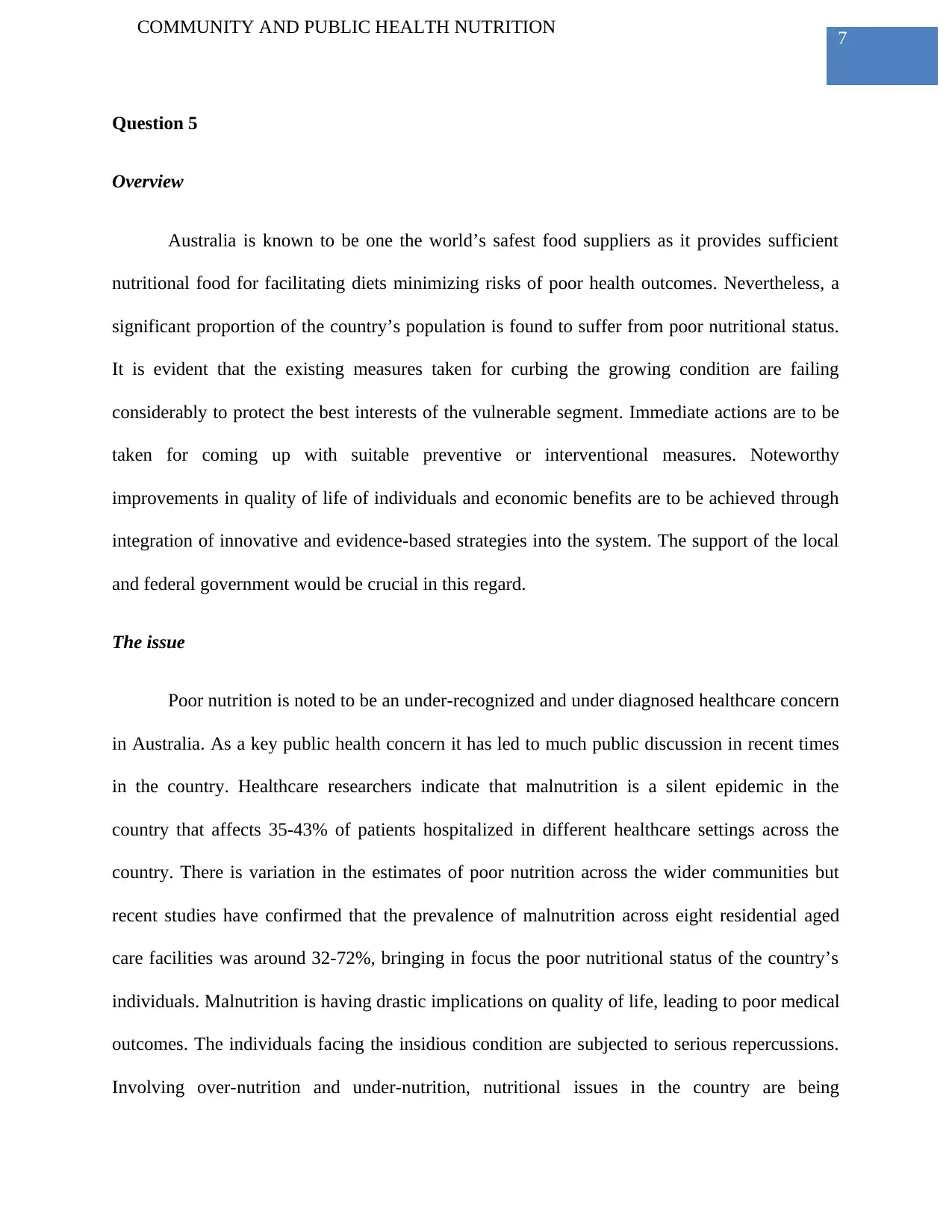
7
COMMUNITY AND PUBLIC HEALTH NUTRITION
Question 5
Overview
Australia is known to be one the world’s safest food suppliers as it provides sufficient
nutritional food for facilitating diets minimizing risks of poor health outcomes. Nevertheless, a
significant proportion of the country’s population is found to suffer from poor nutritional status.
It is evident that the existing measures taken for curbing the growing condition are failing
considerably to protect the best interests of the vulnerable segment. Immediate actions are to be
taken for coming up with suitable preventive or interventional measures. Noteworthy
improvements in quality of life of individuals and economic benefits are to be achieved through
integration of innovative and evidence-based strategies into the system. The support of the local
and federal government would be crucial in this regard.
The issue
Poor nutrition is noted to be an under-recognized and under diagnosed healthcare concern
in Australia. As a key public health concern it has led to much public discussion in recent times
in the country. Healthcare researchers indicate that malnutrition is a silent epidemic in the
country that affects 35-43% of patients hospitalized in different healthcare settings across the
country. There is variation in the estimates of poor nutrition across the wider communities but
recent studies have confirmed that the prevalence of malnutrition across eight residential aged
care facilities was around 32-72%, bringing in focus the poor nutritional status of the country’s
individuals. Malnutrition is having drastic implications on quality of life, leading to poor medical
outcomes. The individuals facing the insidious condition are subjected to serious repercussions.
Involving over-nutrition and under-nutrition, nutritional issues in the country are being
COMMUNITY AND PUBLIC HEALTH NUTRITION
Question 5
Overview
Australia is known to be one the world’s safest food suppliers as it provides sufficient
nutritional food for facilitating diets minimizing risks of poor health outcomes. Nevertheless, a
significant proportion of the country’s population is found to suffer from poor nutritional status.
It is evident that the existing measures taken for curbing the growing condition are failing
considerably to protect the best interests of the vulnerable segment. Immediate actions are to be
taken for coming up with suitable preventive or interventional measures. Noteworthy
improvements in quality of life of individuals and economic benefits are to be achieved through
integration of innovative and evidence-based strategies into the system. The support of the local
and federal government would be crucial in this regard.
The issue
Poor nutrition is noted to be an under-recognized and under diagnosed healthcare concern
in Australia. As a key public health concern it has led to much public discussion in recent times
in the country. Healthcare researchers indicate that malnutrition is a silent epidemic in the
country that affects 35-43% of patients hospitalized in different healthcare settings across the
country. There is variation in the estimates of poor nutrition across the wider communities but
recent studies have confirmed that the prevalence of malnutrition across eight residential aged
care facilities was around 32-72%, bringing in focus the poor nutritional status of the country’s
individuals. Malnutrition is having drastic implications on quality of life, leading to poor medical
outcomes. The individuals facing the insidious condition are subjected to serious repercussions.
Involving over-nutrition and under-nutrition, nutritional issues in the country are being
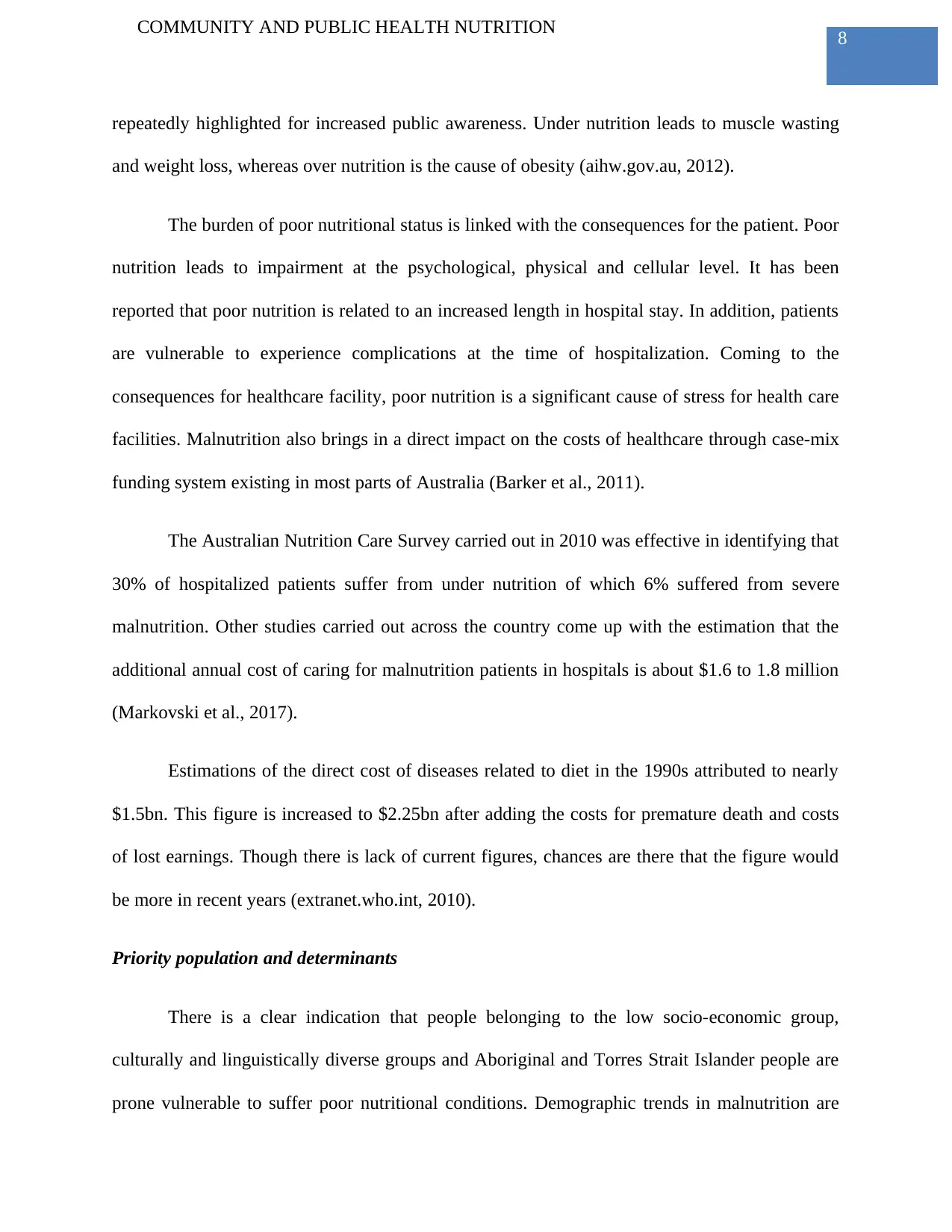
8
COMMUNITY AND PUBLIC HEALTH NUTRITION
repeatedly highlighted for increased public awareness. Under nutrition leads to muscle wasting
and weight loss, whereas over nutrition is the cause of obesity (aihw.gov.au, 2012).
The burden of poor nutritional status is linked with the consequences for the patient. Poor
nutrition leads to impairment at the psychological, physical and cellular level. It has been
reported that poor nutrition is related to an increased length in hospital stay. In addition, patients
are vulnerable to experience complications at the time of hospitalization. Coming to the
consequences for healthcare facility, poor nutrition is a significant cause of stress for health care
facilities. Malnutrition also brings in a direct impact on the costs of healthcare through case-mix
funding system existing in most parts of Australia (Barker et al., 2011).
The Australian Nutrition Care Survey carried out in 2010 was effective in identifying that
30% of hospitalized patients suffer from under nutrition of which 6% suffered from severe
malnutrition. Other studies carried out across the country come up with the estimation that the
additional annual cost of caring for malnutrition patients in hospitals is about $1.6 to 1.8 million
(Markovski et al., 2017).
Estimations of the direct cost of diseases related to diet in the 1990s attributed to nearly
$1.5bn. This figure is increased to $2.25bn after adding the costs for premature death and costs
of lost earnings. Though there is lack of current figures, chances are there that the figure would
be more in recent years (extranet.who.int, 2010).
Priority population and determinants
There is a clear indication that people belonging to the low socio-economic group,
culturally and linguistically diverse groups and Aboriginal and Torres Strait Islander people are
prone vulnerable to suffer poor nutritional conditions. Demographic trends in malnutrition are
COMMUNITY AND PUBLIC HEALTH NUTRITION
repeatedly highlighted for increased public awareness. Under nutrition leads to muscle wasting
and weight loss, whereas over nutrition is the cause of obesity (aihw.gov.au, 2012).
The burden of poor nutritional status is linked with the consequences for the patient. Poor
nutrition leads to impairment at the psychological, physical and cellular level. It has been
reported that poor nutrition is related to an increased length in hospital stay. In addition, patients
are vulnerable to experience complications at the time of hospitalization. Coming to the
consequences for healthcare facility, poor nutrition is a significant cause of stress for health care
facilities. Malnutrition also brings in a direct impact on the costs of healthcare through case-mix
funding system existing in most parts of Australia (Barker et al., 2011).
The Australian Nutrition Care Survey carried out in 2010 was effective in identifying that
30% of hospitalized patients suffer from under nutrition of which 6% suffered from severe
malnutrition. Other studies carried out across the country come up with the estimation that the
additional annual cost of caring for malnutrition patients in hospitals is about $1.6 to 1.8 million
(Markovski et al., 2017).
Estimations of the direct cost of diseases related to diet in the 1990s attributed to nearly
$1.5bn. This figure is increased to $2.25bn after adding the costs for premature death and costs
of lost earnings. Though there is lack of current figures, chances are there that the figure would
be more in recent years (extranet.who.int, 2010).
Priority population and determinants
There is a clear indication that people belonging to the low socio-economic group,
culturally and linguistically diverse groups and Aboriginal and Torres Strait Islander people are
prone vulnerable to suffer poor nutritional conditions. Demographic trends in malnutrition are
⊘ This is a preview!⊘
Do you want full access?
Subscribe today to unlock all pages.

Trusted by 1+ million students worldwide
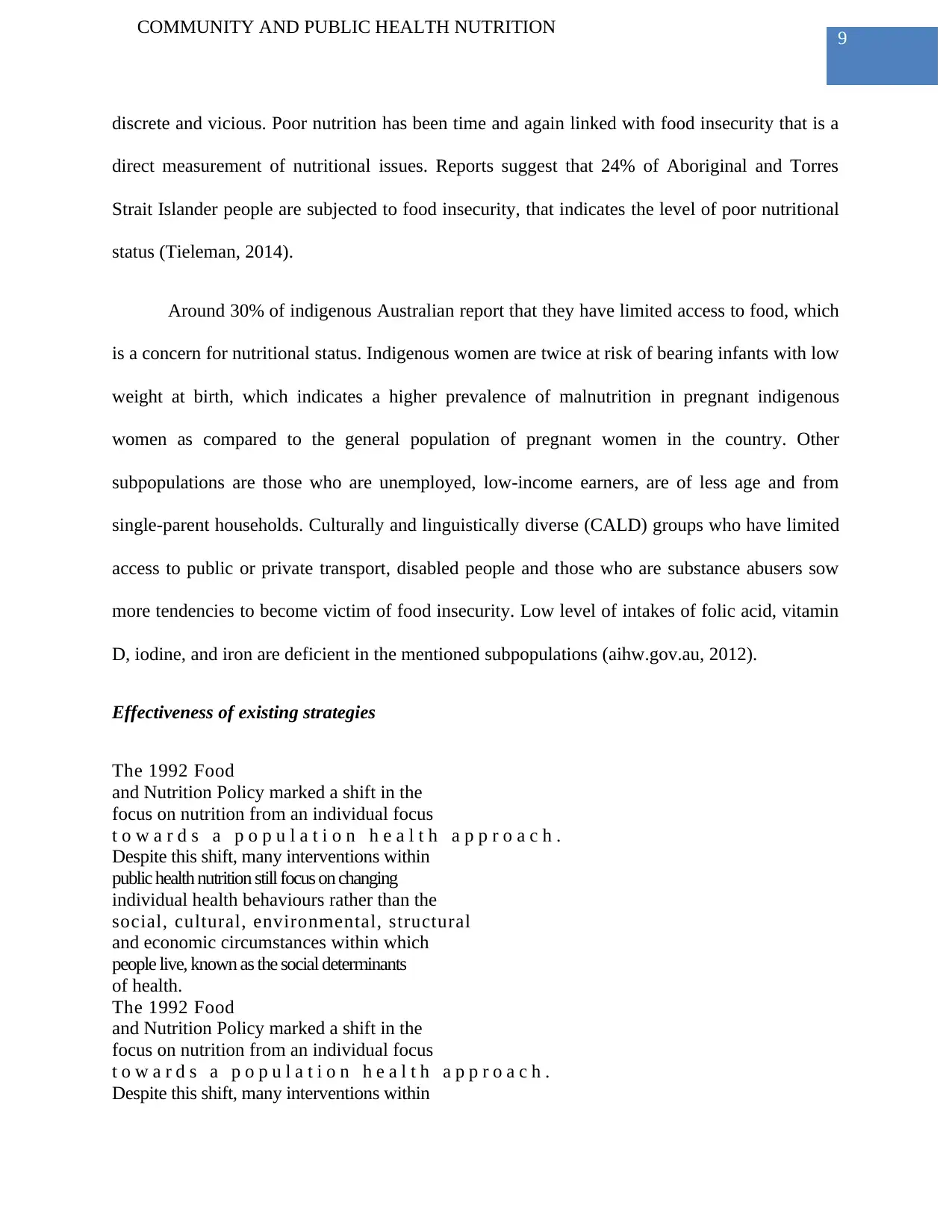
9
COMMUNITY AND PUBLIC HEALTH NUTRITION
discrete and vicious. Poor nutrition has been time and again linked with food insecurity that is a
direct measurement of nutritional issues. Reports suggest that 24% of Aboriginal and Torres
Strait Islander people are subjected to food insecurity, that indicates the level of poor nutritional
status (Tieleman, 2014).
Around 30% of indigenous Australian report that they have limited access to food, which
is a concern for nutritional status. Indigenous women are twice at risk of bearing infants with low
weight at birth, which indicates a higher prevalence of malnutrition in pregnant indigenous
women as compared to the general population of pregnant women in the country. Other
subpopulations are those who are unemployed, low-income earners, are of less age and from
single-parent households. Culturally and linguistically diverse (CALD) groups who have limited
access to public or private transport, disabled people and those who are substance abusers sow
more tendencies to become victim of food insecurity. Low level of intakes of folic acid, vitamin
D, iodine, and iron are deficient in the mentioned subpopulations (aihw.gov.au, 2012).
Effectiveness of existing strategies
The 1992 Food
and Nutrition Policy marked a shift in the
focus on nutrition from an individual focus
t o w a r d s a p o p u l a t i o n h e a l t h a p p r o a c h .
Despite this shift, many interventions within
public health nutrition still focus on changing
individual health behaviours rather than the
social, cultural, environmental, structural
and economic circumstances within which
people live, known as the social determinants
of health.
The 1992 Food
and Nutrition Policy marked a shift in the
focus on nutrition from an individual focus
t o w a r d s a p o p u l a t i o n h e a l t h a p p r o a c h .
Despite this shift, many interventions within
COMMUNITY AND PUBLIC HEALTH NUTRITION
discrete and vicious. Poor nutrition has been time and again linked with food insecurity that is a
direct measurement of nutritional issues. Reports suggest that 24% of Aboriginal and Torres
Strait Islander people are subjected to food insecurity, that indicates the level of poor nutritional
status (Tieleman, 2014).
Around 30% of indigenous Australian report that they have limited access to food, which
is a concern for nutritional status. Indigenous women are twice at risk of bearing infants with low
weight at birth, which indicates a higher prevalence of malnutrition in pregnant indigenous
women as compared to the general population of pregnant women in the country. Other
subpopulations are those who are unemployed, low-income earners, are of less age and from
single-parent households. Culturally and linguistically diverse (CALD) groups who have limited
access to public or private transport, disabled people and those who are substance abusers sow
more tendencies to become victim of food insecurity. Low level of intakes of folic acid, vitamin
D, iodine, and iron are deficient in the mentioned subpopulations (aihw.gov.au, 2012).
Effectiveness of existing strategies
The 1992 Food
and Nutrition Policy marked a shift in the
focus on nutrition from an individual focus
t o w a r d s a p o p u l a t i o n h e a l t h a p p r o a c h .
Despite this shift, many interventions within
public health nutrition still focus on changing
individual health behaviours rather than the
social, cultural, environmental, structural
and economic circumstances within which
people live, known as the social determinants
of health.
The 1992 Food
and Nutrition Policy marked a shift in the
focus on nutrition from an individual focus
t o w a r d s a p o p u l a t i o n h e a l t h a p p r o a c h .
Despite this shift, many interventions within
Paraphrase This Document
Need a fresh take? Get an instant paraphrase of this document with our AI Paraphraser
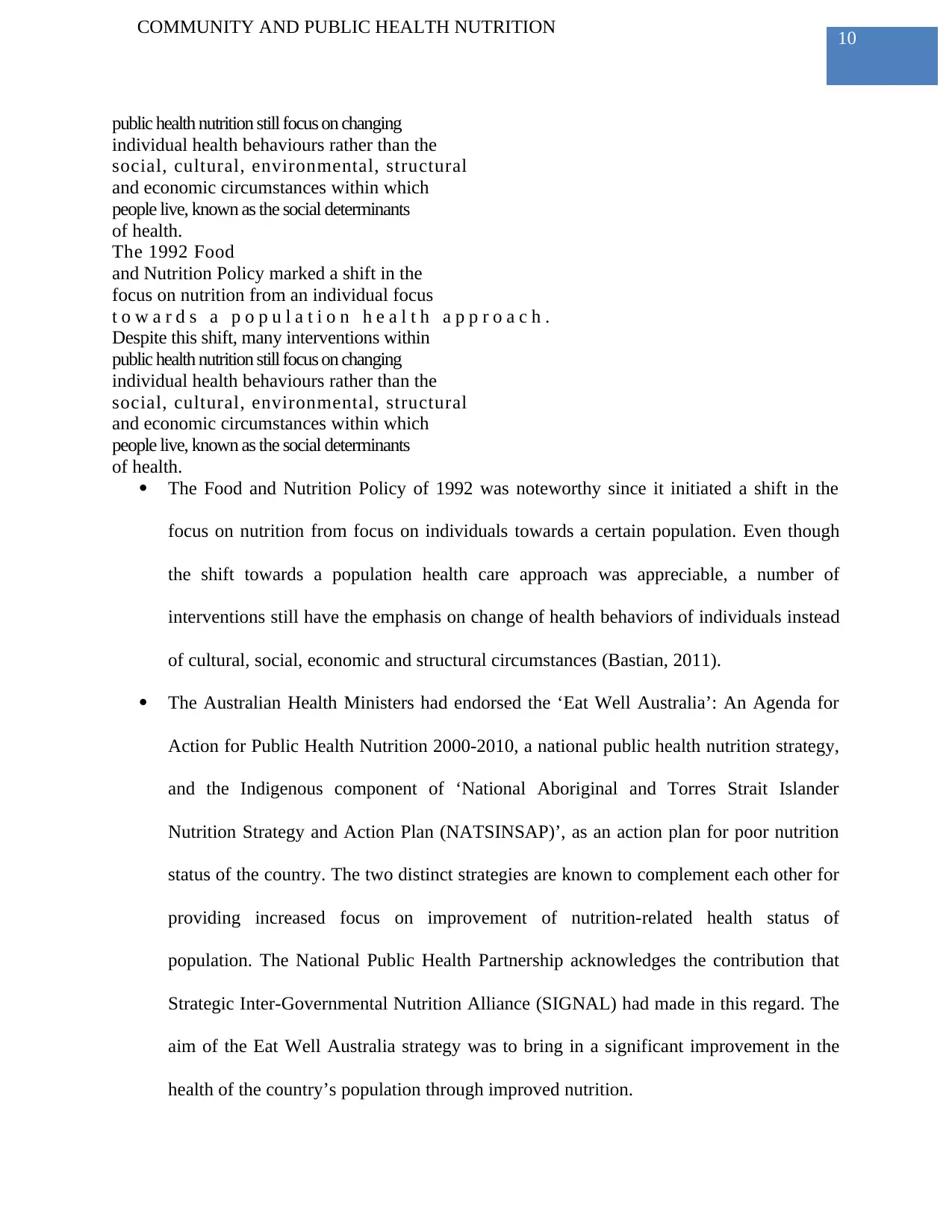
10
COMMUNITY AND PUBLIC HEALTH NUTRITION
public health nutrition still focus on changing
individual health behaviours rather than the
social, cultural, environmental, structural
and economic circumstances within which
people live, known as the social determinants
of health.
The 1992 Food
and Nutrition Policy marked a shift in the
focus on nutrition from an individual focus
t o w a r d s a p o p u l a t i o n h e a l t h a p p r o a c h .
Despite this shift, many interventions within
public health nutrition still focus on changing
individual health behaviours rather than the
social, cultural, environmental, structural
and economic circumstances within which
people live, known as the social determinants
of health.
The Food and Nutrition Policy of 1992 was noteworthy since it initiated a shift in the
focus on nutrition from focus on individuals towards a certain population. Even though
the shift towards a population health care approach was appreciable, a number of
interventions still have the emphasis on change of health behaviors of individuals instead
of cultural, social, economic and structural circumstances (Bastian, 2011).
The Australian Health Ministers had endorsed the ‘Eat Well Australia’: An Agenda for
Action for Public Health Nutrition 2000-2010, a national public health nutrition strategy,
and the Indigenous component of ‘National Aboriginal and Torres Strait Islander
Nutrition Strategy and Action Plan (NATSINSAP)’, as an action plan for poor nutrition
status of the country. The two distinct strategies are known to complement each other for
providing increased focus on improvement of nutrition-related health status of
population. The National Public Health Partnership acknowledges the contribution that
Strategic Inter-Governmental Nutrition Alliance (SIGNAL) had made in this regard. The
aim of the Eat Well Australia strategy was to bring in a significant improvement in the
health of the country’s population through improved nutrition.
COMMUNITY AND PUBLIC HEALTH NUTRITION
public health nutrition still focus on changing
individual health behaviours rather than the
social, cultural, environmental, structural
and economic circumstances within which
people live, known as the social determinants
of health.
The 1992 Food
and Nutrition Policy marked a shift in the
focus on nutrition from an individual focus
t o w a r d s a p o p u l a t i o n h e a l t h a p p r o a c h .
Despite this shift, many interventions within
public health nutrition still focus on changing
individual health behaviours rather than the
social, cultural, environmental, structural
and economic circumstances within which
people live, known as the social determinants
of health.
The Food and Nutrition Policy of 1992 was noteworthy since it initiated a shift in the
focus on nutrition from focus on individuals towards a certain population. Even though
the shift towards a population health care approach was appreciable, a number of
interventions still have the emphasis on change of health behaviors of individuals instead
of cultural, social, economic and structural circumstances (Bastian, 2011).
The Australian Health Ministers had endorsed the ‘Eat Well Australia’: An Agenda for
Action for Public Health Nutrition 2000-2010, a national public health nutrition strategy,
and the Indigenous component of ‘National Aboriginal and Torres Strait Islander
Nutrition Strategy and Action Plan (NATSINSAP)’, as an action plan for poor nutrition
status of the country. The two distinct strategies are known to complement each other for
providing increased focus on improvement of nutrition-related health status of
population. The National Public Health Partnership acknowledges the contribution that
Strategic Inter-Governmental Nutrition Alliance (SIGNAL) had made in this regard. The
aim of the Eat Well Australia strategy was to bring in a significant improvement in the
health of the country’s population through improved nutrition.
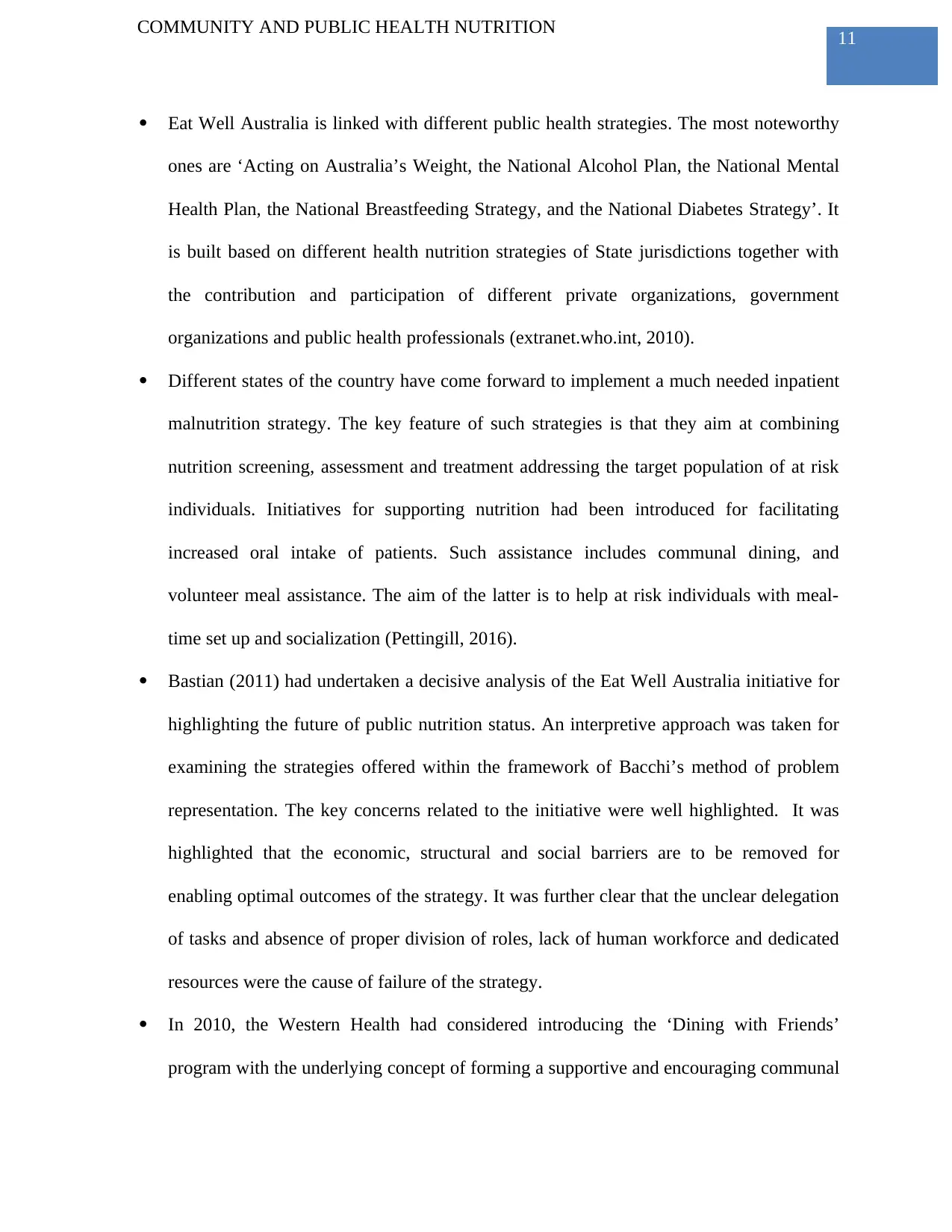
11
COMMUNITY AND PUBLIC HEALTH NUTRITION
Eat Well Australia is linked with different public health strategies. The most noteworthy
ones are ‘Acting on Australia’s Weight, the National Alcohol Plan, the National Mental
Health Plan, the National Breastfeeding Strategy, and the National Diabetes Strategy’. It
is built based on different health nutrition strategies of State jurisdictions together with
the contribution and participation of different private organizations, government
organizations and public health professionals (extranet.who.int, 2010).
Different states of the country have come forward to implement a much needed inpatient
malnutrition strategy. The key feature of such strategies is that they aim at combining
nutrition screening, assessment and treatment addressing the target population of at risk
individuals. Initiatives for supporting nutrition had been introduced for facilitating
increased oral intake of patients. Such assistance includes communal dining, and
volunteer meal assistance. The aim of the latter is to help at risk individuals with meal-
time set up and socialization (Pettingill, 2016).
Bastian (2011) had undertaken a decisive analysis of the Eat Well Australia initiative for
highlighting the future of public nutrition status. An interpretive approach was taken for
examining the strategies offered within the framework of Bacchi’s method of problem
representation. The key concerns related to the initiative were well highlighted. It was
highlighted that the economic, structural and social barriers are to be removed for
enabling optimal outcomes of the strategy. It was further clear that the unclear delegation
of tasks and absence of proper division of roles, lack of human workforce and dedicated
resources were the cause of failure of the strategy.
In 2010, the Western Health had considered introducing the ‘Dining with Friends’
program with the underlying concept of forming a supportive and encouraging communal
COMMUNITY AND PUBLIC HEALTH NUTRITION
Eat Well Australia is linked with different public health strategies. The most noteworthy
ones are ‘Acting on Australia’s Weight, the National Alcohol Plan, the National Mental
Health Plan, the National Breastfeeding Strategy, and the National Diabetes Strategy’. It
is built based on different health nutrition strategies of State jurisdictions together with
the contribution and participation of different private organizations, government
organizations and public health professionals (extranet.who.int, 2010).
Different states of the country have come forward to implement a much needed inpatient
malnutrition strategy. The key feature of such strategies is that they aim at combining
nutrition screening, assessment and treatment addressing the target population of at risk
individuals. Initiatives for supporting nutrition had been introduced for facilitating
increased oral intake of patients. Such assistance includes communal dining, and
volunteer meal assistance. The aim of the latter is to help at risk individuals with meal-
time set up and socialization (Pettingill, 2016).
Bastian (2011) had undertaken a decisive analysis of the Eat Well Australia initiative for
highlighting the future of public nutrition status. An interpretive approach was taken for
examining the strategies offered within the framework of Bacchi’s method of problem
representation. The key concerns related to the initiative were well highlighted. It was
highlighted that the economic, structural and social barriers are to be removed for
enabling optimal outcomes of the strategy. It was further clear that the unclear delegation
of tasks and absence of proper division of roles, lack of human workforce and dedicated
resources were the cause of failure of the strategy.
In 2010, the Western Health had considered introducing the ‘Dining with Friends’
program with the underlying concept of forming a supportive and encouraging communal
⊘ This is a preview!⊘
Do you want full access?
Subscribe today to unlock all pages.

Trusted by 1+ million students worldwide
1 out of 17
Related Documents
Your All-in-One AI-Powered Toolkit for Academic Success.
+13062052269
info@desklib.com
Available 24*7 on WhatsApp / Email
![[object Object]](/_next/static/media/star-bottom.7253800d.svg)
Unlock your academic potential
Copyright © 2020–2025 A2Z Services. All Rights Reserved. Developed and managed by ZUCOL.





